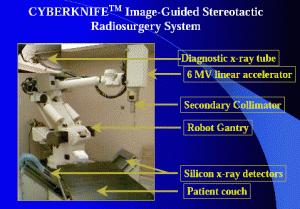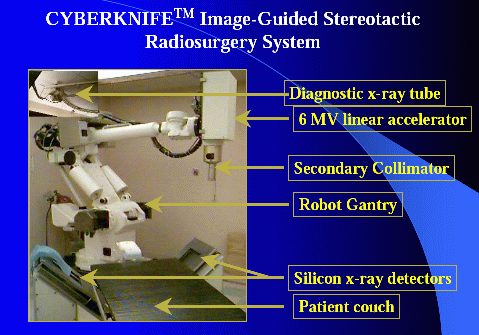 Mercy Health Lacks Cancer Center in Grand Rapids, MI is the latest cancer treatment center offering patients access to the CyberKnife Radiosurgery System, a new treatment alternative that simplifies and targets radiation therapy. Mercy Health Lacks Cancer Center is the only site in West Michigan with CyberKnife technology, which allows patients to undergo fewer treatment sessions, as it provides focused, non-invasive radiation treatment that targets tumors with pinpoint precision.
Mercy Health Lacks Cancer Center in Grand Rapids, MI is the latest cancer treatment center offering patients access to the CyberKnife Radiosurgery System, a new treatment alternative that simplifies and targets radiation therapy. Mercy Health Lacks Cancer Center is the only site in West Michigan with CyberKnife technology, which allows patients to undergo fewer treatment sessions, as it provides focused, non-invasive radiation treatment that targets tumors with pinpoint precision.
According to information available on Mercy Health’s website, the CyberKnife System is a painless radiation treatment that requires no anesthesia or incision, and, despite the name, causes no blood loss. With minimal radiation exposure to healthy tissue and minimal to no side effects or post-treatment complications, the system requires only one to five treatments, compared to weeks of treatment that may be required using traditional radiation therapy. In addition, the CyberKnife allows a short recovery time, with no overnight hospital stay, and many patients resume normal activities immediately after treatment.
The benefits of the novel technology are being increasingly recognized by experts. Steven Chang, a neurosurgeon at the Stanford University Cancer Center, notes that while radiosurgery was previously restricted to treating tumors within the head, the majority of tumors occur outside the head. “By going to a frameless platform such as the CyberKnife we now can significantly expand our ability to treat tumors throughout the body,” he said in a treatment overview video published by Mercy Health.
CyberKnife uses image-guided technology and advanced robotics to achieve sub-millimeter accuracy and target radiation beams, thus destroying abnormal cells within the body, while sparing healthy cells. The system utilizes a linear accelerator that is mounted to a flexible, robotic arm, which can move around the patient in nearly a 360 degree arc, allowing multiple beams of radiation to target the exact shape and location of the tumor.
The CyberKnife system’s continual image guidance software allows for the delivery of high radiation doses with pinpoint accuracy, while automatically correcting for patient movement such as breathing. Since radiation beams adjust in real-time to patient and tumor movement, there is less damage to surrounding healthy tissue. That is an improvement in the technology of which Neil Christie, a thoracic surgeon at the University of Pittsburgh Medical Center, is particularly enthusiastic about.
[adrotate group=”1″]
Since a lung tumor moves constantly with respiration, he explains, conventional radiation requires doctors to radiate the whole area where the tumor might be in. “With the CyberKnife, the radiation device actually tracks the tumor and allows us to give a very focused radiation to the tumor and not the surrounding normal lung,” he said.
The CyberKnife System can be used to treat many cancerous and non-cancerous tumors throughout the body. At Mercy Health Lacks Cancer Center, the CyberKnife is currently being used to treat brain and spinal tumors, liver cancer, lung cancer, pancreatic cancer, prostate cancer.
For John Kresl, an oncologist at the Barrow Neurological Institute of St. Joseph’s Hospital and Medical Center, the system “made the biggest impression” on him early on, “with regards to being able to offer treatments to some patients who haven’t had any other options. This allowed us now to offer them something that wasn’t available before, and it wasn’t only effective, but it was safe,” he assured.


